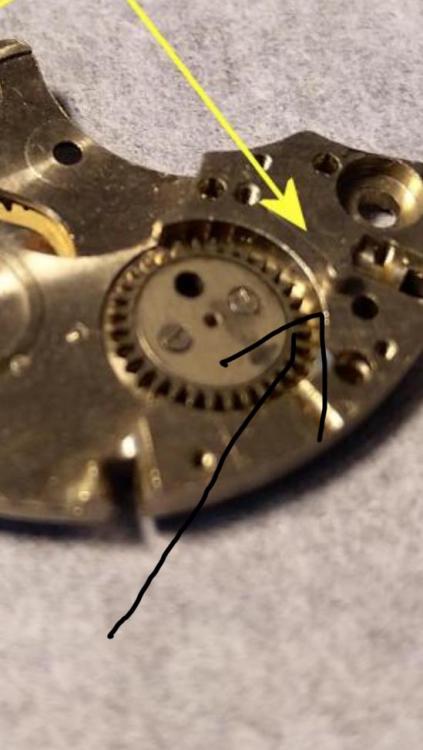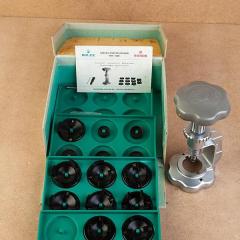Leaderboard
Popular Content
Showing content with the highest reputation on 08/02/19 in all areas
-
Real pros can kick me. I'd be super happy with any of these droplets and move on to the next issue, of which there's never scarcity.2 points
-
Staking tools and jeweling tools overlap quite a bit. In general I use a jeweling tool anytime something needs to be pushed, a staking tool when a hammer is involved. The jeweling tool can offer a lot more control over what's happening. You should check that the pusher has a hole deep enough to pass the top of the balance staff, sometimes they are surprisingly shallow. Ideally use a stump that just passes the roller table. Your Seitz should do a great job of resetting the hs collet. Many just set the balance on a bench block and press on with tweezers, obviously this risks a slip taking out the upper pivot and/or the hairspring. You can never have too many stumps and pushers for the jeweling tool. I probably have a couple hundred of each and still make specials regularly.1 point
-
I wonder if the thicker end stone has a smaller radius of curvature to its top surface, resulting in greater magnification, like a stronger lens. If so then identical size drops placed onto the flat surfaces of each jewel will look different sizes when viewed through the jewel, with the thicker jewel showing the greater apparent size. .... just a thought. :-)1 point
-
1 point
-
What should happen is that when you push the stem into a movement, and tighten down the setting lever screw, you're basically moving the setting lever into position such that, as @Nucejoe says, the 'pin' on the setting lever locks into position in the groove in the stem. You say everything is fine when the movement is out of the case; this only happens when you try and re-case. This therefore sounds like the stem is too short ... or that there is some obstruction (e.g. dirt in the crown) that is stopping it pushing in fully. If the stem is not far enough into the movement then when you screw the setting lever into position the pin will not engage with the stem and it will subsequently pull straight out when you try and use it as you're finding! Is this the original stem/crown that came with the movement and case or is this one of the replacements you mention? If it is the original then first check there is nothing in the crown that might be causing a slight obstruction. Now with the movement out of the case engage the stem and check the setting works as expected. Pull the stem into the setting position before unscrewing the setting lever screw just enough to remove the stem. Recase the movement and push the stem/crown in and ensure it is properly engaged before tightening down the setting lever screw. [Conversely if it is not the original stem then it sounds like it could be fractionally short and not going into the movement enough ... come back if this is the case for more advice!].1 point
-
1 point
-
1 point
-
The rear point would have fit in a divot in a vice to support it while it was worked with a bow. The plate would be handheld. Yes you need a premade hole to begin with. Watchmaker's vices used to come with the little divots in the jaws for the many bow powered special tools.1 point
-
Hmmm, well they are all for automatic barrels. Glissalube A for brass (not plated), B for aluminum (not seen that often anymore). 8217 and Kluber P125 are for anywhere (but doesn't necessarily mean they are ideal). Manual wind watches have no need for these greases.1 point
-
Wouldn't know for sure unless we open it up. Weak or broken spring would also cause this problem. Would probably bet on it being the brake though.1 point
-
I'm no expert on reselling watches—I keep all mine—but, you can't go wrong with a new crown.1 point
-
Can you post what make and calibre of movement it is, then it’s quite simple to look up the lift angle in a lot of cases. Google for Lepsi Lift Angle and you’ll find lots of info. As for the lines, yep all looks normal (for a poorly running watch). I disagree slightly with some of the above as imho the BE of 1.4 is a bit too high. Sort out that (see if you can get it down to 0.5 or below) and regulate the watch a bit and see what lines you get, I think the amplitude reading is probably miscalculated as the BE and regulation are out. But it’s a good place to start from and I don’t ‘think’ there’s anything wrong with your machine. Sent from my iPad using Tapatalk1 point
-
Generally re-assembly is done in the reverse order of disassembly, so there may be enough clues in the original video. There is no hard and fast rule about the order parts come off and go back on, but generally I start by letting down the mainspring, remove crown and stem, then remove hands, then dial, then from the balance side, balance +bridge, balance fork if appropriate at this point, then depending on the way it is constructed, the winder gears, mainspring bridge+mainspring barrel, other bridges and gears in whichever order is appropriate, then balance fork if other things prevented its removal till this point, then turn over, remove keyless work if necessary. I then strip and clean the mainspring etc. More complex watches will have other steps. Re-assembly is generally this process in reverse. Some good close up pictures of your de-constructed watch should give us enough clues to guide you in re-assembly. Finally, don't panic, this is all part of the learning process. Just take care, go slowly and methodically, don't use force, all watch parts are delicate. If you get the re-assembly order wrong, nothing bad will happen, you will just need to reverse the bit you got wrong and work from there. It can be a little time consuming, but if eye fatigue or frustration are starting to set in, put it aside, do something else, come back when you have rested and gathered your thoughts.1 point
-
Grease for auto barrels need to slip just enough. Moebius 8217 is the standard grease, Kluber P125 is also a standard if a bit more high tech grease. Then there is 8212, also known as Glissalube B, for aluminum barrels, and 8213, Glissalube A, for brass barrels. Easy to remember as the letter code matches the opposite metal. Some barrels/ calibers are very sensitive to the braking grease used, and may lose a significant amount of wind because of too slippery a braking grease, inversely, may overstress winding components if the grease is too aggressive at braking. Best to follow the manufacturer's advice, and when lacking that, go on experience. But 8217 is a good one to try.1 point
-
1 point
-
you clearly know your stuff mate, and amazing quality photos... I just put them on my Tab 4 and will follow your pictorial while trying to disassemble a 2836 bought for practicing. Thanks for sharing, sharing knowledge is what makes WRT such a great forum1 point
-
1 point
-
Great long term goal acheivement :Thumbsup: Just started myself and that would be a great goal for me as well. Thank you for sharing1 point
-
My vote is nay. Filing violates watchmakers code of ethics. Best Regards0 points










